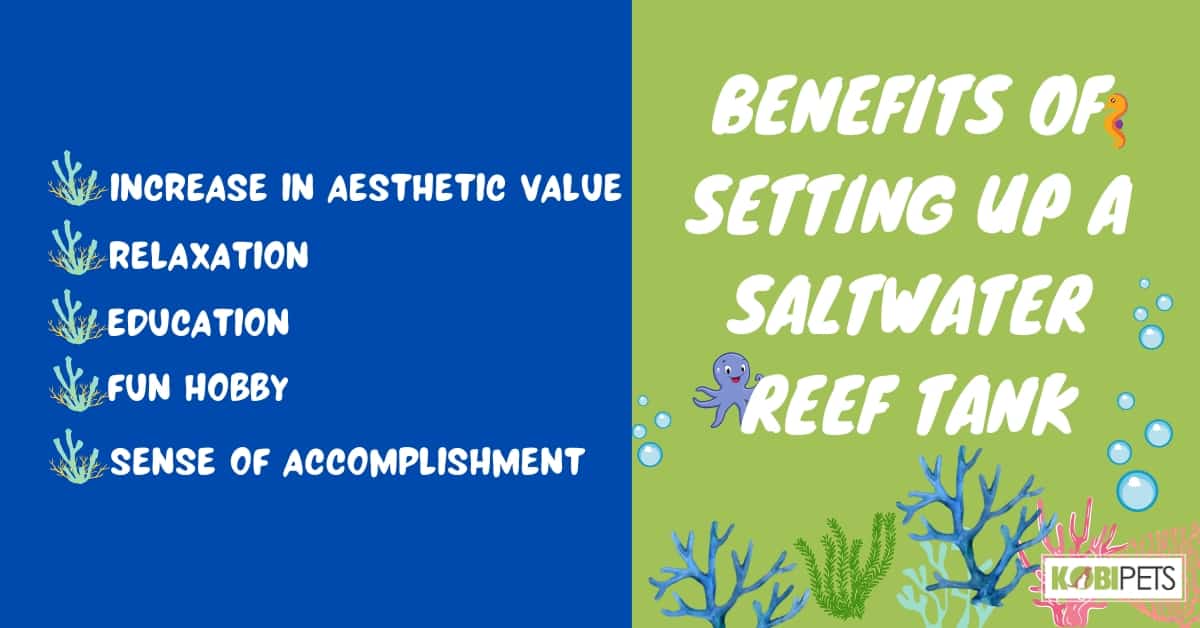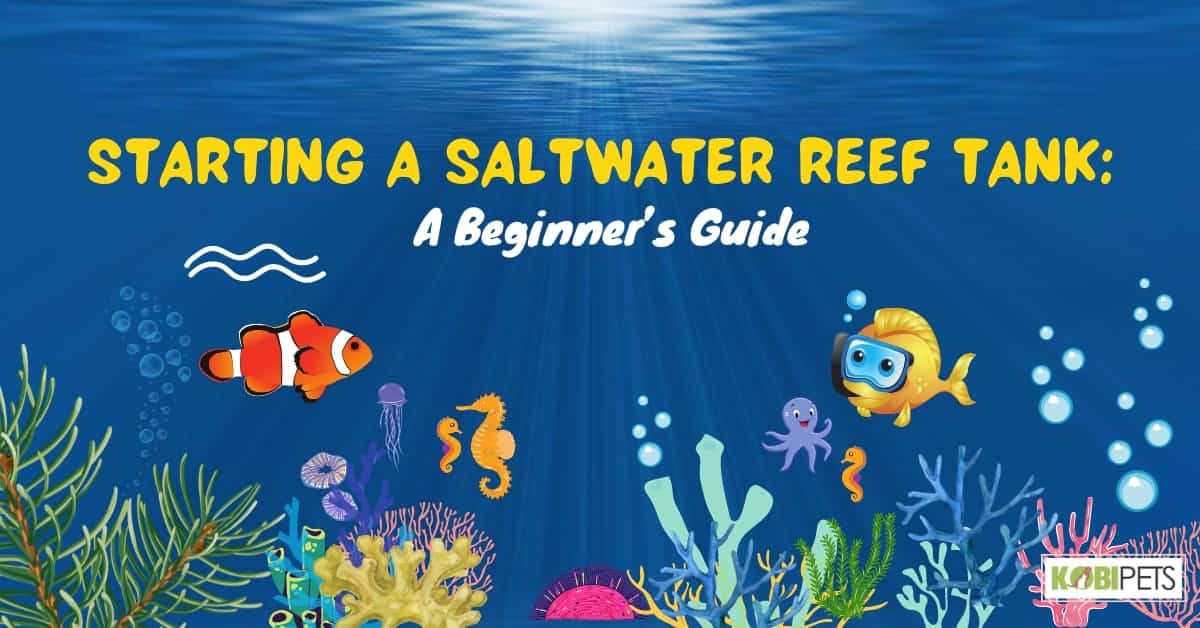
Getting started on your saltwater reef tank adventure requires you to consider the right size and materials for the aquarium setup, as well as the required equipment for filtration and lighting. With careful selection of substrate and livestock, you’ll be ready to establish proper water chemistry and start enjoying your unique marine environment.
This beginner’s guide will provide you with an overview of what is involved in starting a saltwater reef tank, from selecting the right equipment and livestock to maintaining proper water chemistry. With the right preparation, you’ll be ready to start your own reef tank in no time!
Benefits of Setting Up a Saltwater Reef Tank
Setting up a saltwater reef tank is a great way to introduce yourself to the exciting world of marine aquaria keeping. It offers opportunities for exploration, learning about aquatic animals, and hours of entertainment as you build an incredible undersea ecosystem.
Saltwater reef tanks can be challenging, but the rewards are well worth it – from the beauty of the corals and fish to the joy of watching their behavior and interaction.
- Increase in Aesthetic Value: Setting up a saltwater reef tank in your home can significantly increase the aesthetic value of any room, with its vibrant colors and active aquatic life providing an impressive visual display.
- Relaxation: Watching fish swim around the artificial environment of a reef tank is calming and therapeutic; it can help relieve stress and provide a soothing background to any space.
- Education: Setting up a saltwater reef tank is like having your own little living laboratory, where you can study the unique ecosystems and behaviors of different species of marine life in detail as they interact with each other and their environment.
- Fun Hobby: Taking care of a reef tank is an enjoyable and rewarding experience; it can be a fun hobby that provides hours of entertainment.
- Sense of Accomplishment: Seeing your saltwater reef tank thrive after all the hard work you’ve put into it is immensely satisfying, providing a sense of accomplishment and pride in your efforts.
By following the steps outlined in this beginner’s guide, you will be well on your way to creating an amazing saltwater reef tank that you can enjoy for years to come.
What You Need to Get Started
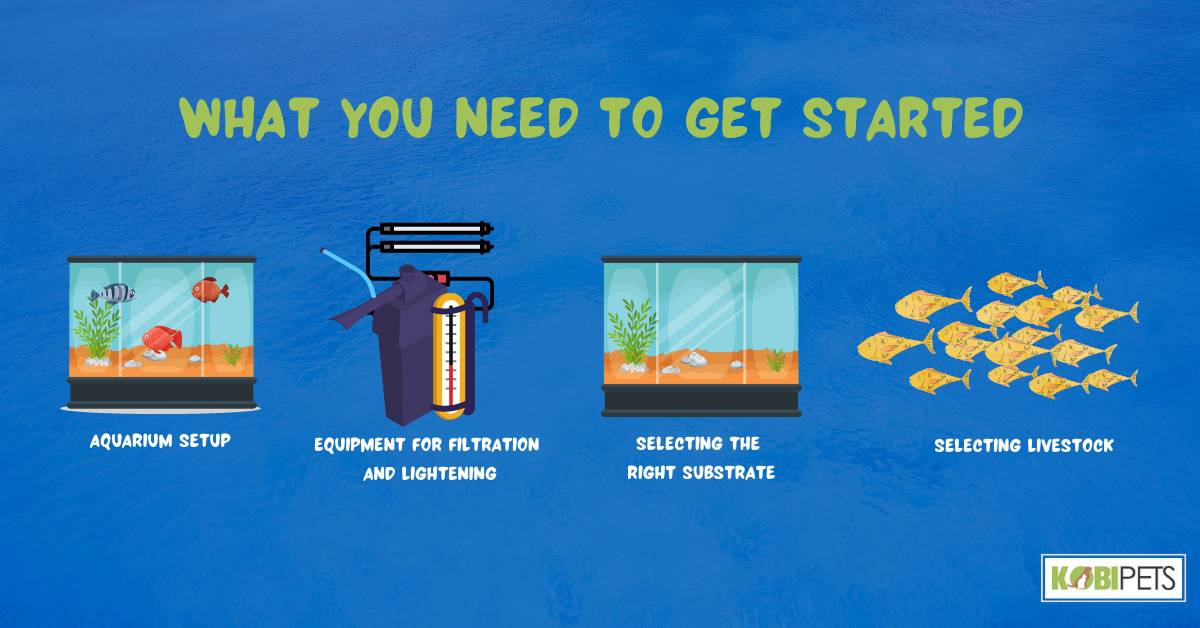
Aquarium Setup: Choosing the Right Size and Materials
Aquarium setup is a crucial part of the fish-keeping process and making sure that you select the right size and materials for your tank is essential to your fish’s well-being. When properly considered and executed, aquarium setup will be a simplistic and straightforward process, allowing you to enjoy your new aquatic habitat in no time.
| Size | Material |
Recommended for
|
| 10 gallon | Glass or Acrylic |
Beginner aquarists, Beta fish, small aquatic species like frogs and shrimp
|
| 20 gallon | Glass or Acrylic |
Small community fish and larger ones that only need one tank mate, live plants, and fancy bottom filter systems.
|
| 40-gallon or larger | Glass or Acrylic (Please note: A 40 Gallon tank requires a greater amount of energy to maintain) |
Larger community fish, Goldfish, Live Plants, Reef Aquariums.
|
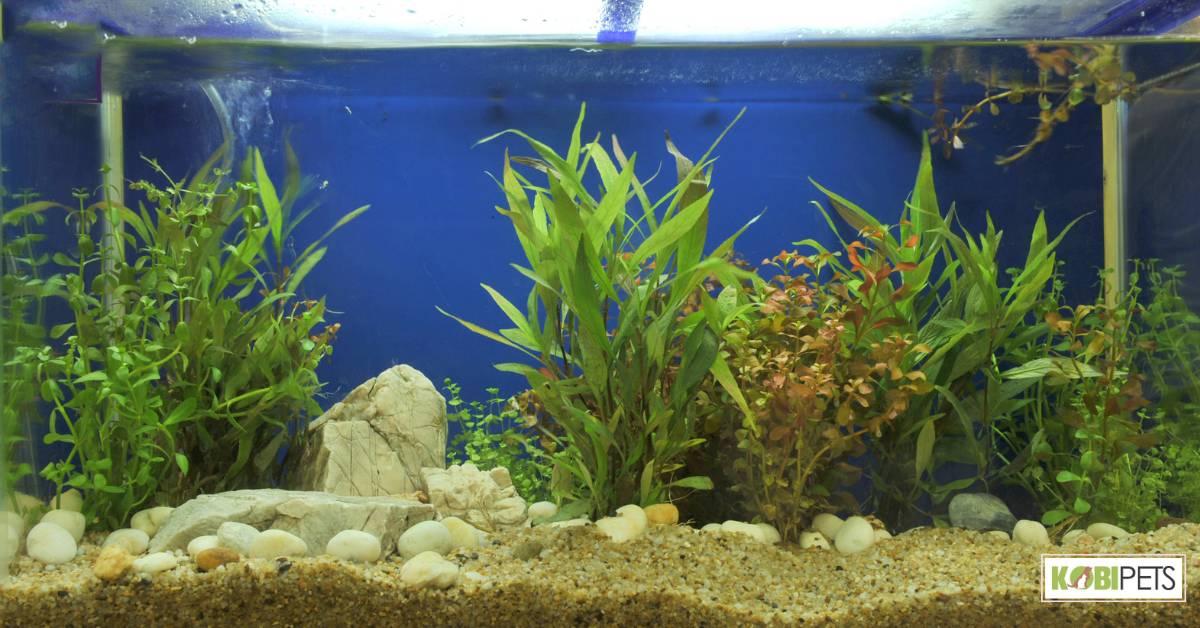
Equipment for Filtration and Lightening
Filtering and lighting your water is an important step in maintaining a well-rounded home care routine. Utilizing the right equipment can make this process easier and more efficient.
Different filtering options come with unique technical specifications, making it possible for every household to find a solution tailored to their specific needs. From countertop filters to whole house systems, learn how the right filtration and lighting equipment can positively impact your home environment.
Filtration System
A filtration system is essential for maintaining water quality and providing a healthy environment for your aquarium inhabitants. Common types of filter systems include hang-on back filters, canister filters, power filters, under gravel filters, wet/dry trickle filters, and more.
Protein Skimmer
Protein skimmers help to remove dissolved waste, bacteria, and other organic compounds from the water column. This helps to keep the aquarium clean and healthy, reducing nitrate and phosphate levels.
Heaters and Chillers
Heaters are used to maintain a consistent temperature for your tank, while chillers can be used to reduce temperatures in warmer climates.
Lighting
Proper lighting is essential for triggering the growth of coral and other invertebrates in your reef tank, as well as providing a stimulating visual display. Different types of lights to consider include LED, T5 fluorescent, and metal halide bulbs.
Water Pumps
Water pumps are used to provide water circulation, oxygenation, and waves throughout the tank, creating a more natural environment for your fish.
Test Kits
Test kits are necessary for monitoring water parameters such as pH, alkalinity, ammonia, nitrite, and nitrate levels. This will help you to maintain a healthy aquatic environment for your fish.
Aquarium Salt
To create a saltwater aquarium, you need to add an appropriate amount of aquarium salt to the tank water. This helps to maintain the correct salinity levels and provide minerals for your fish.
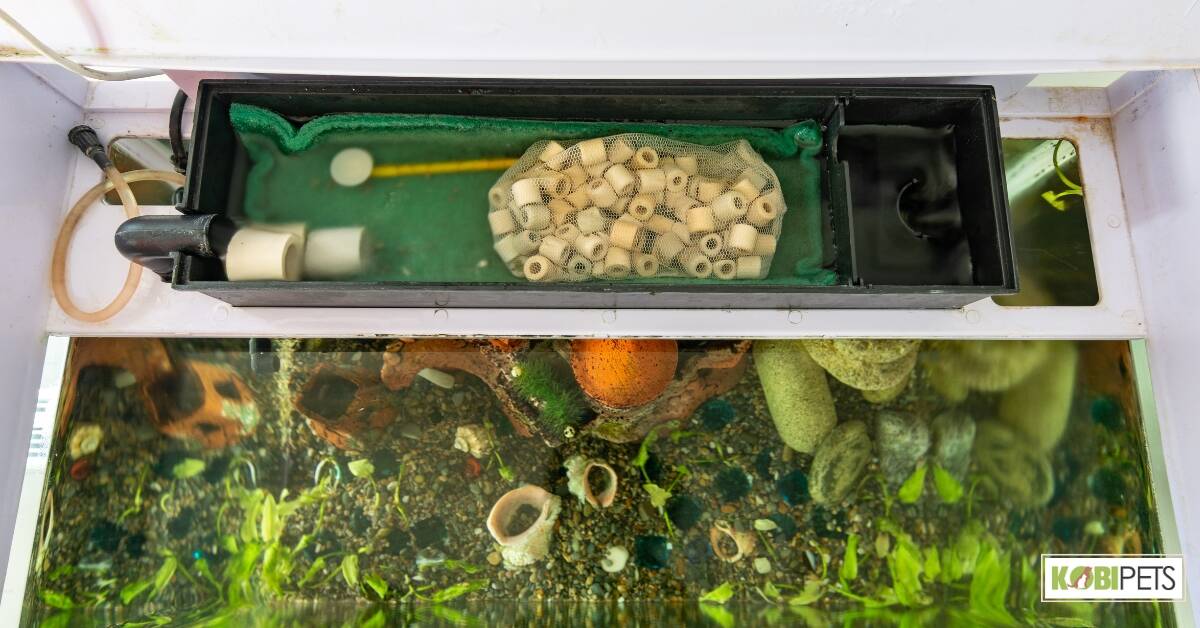
Selecting the Right Substrate
When it comes to selecting the right substrate for a saltwater reef tank, you’ll want to look for materials that are natural and that help maintain the chemical balance in your tank. Aragonite is one of the most popular choices as it helps maintain calcium levels and keeps water alkalinity consistent over time.
Natural coral sands provide both aesthetic appeal and necessary microorganisms that benefit the residents of a saltwater reef tank, while special mixes like crushed coral or live sand may be best suited for tanks with more aggressive fish species.
Ultimately, choosing the right substrate will depend on what type of creatures you plan to house in your tank – so research carefully before making any decision.
| Substrate Type | Properties | Suitable for |
| gravel | Inexpensive and easy to clean, available in a wide range of colors and sizes. It also allows water to move quickly through the substrate. |
Community Aquariums, Goldfish tanks, Fish only tanks.
|
| Sand | Non-abrasive on fins, cushions fish as they swim close to the surface of the substrate tank. Low maintenance and perfect for bottom-dwelling fish like Loaches, Eels, or Catfish. It does require regular vacuuming to remove debris. |
Live plants tanks, Bottom-dwelling fish tanks.
|
| Clay Pebbles or Beads | Allows for great water circulation while allowing roots to receive oxygen from water movement between them. Easy cleaning with a small siphon tube when performing regular maintenance. |
Platy fish tanks, Live Plants Aquariums.
|
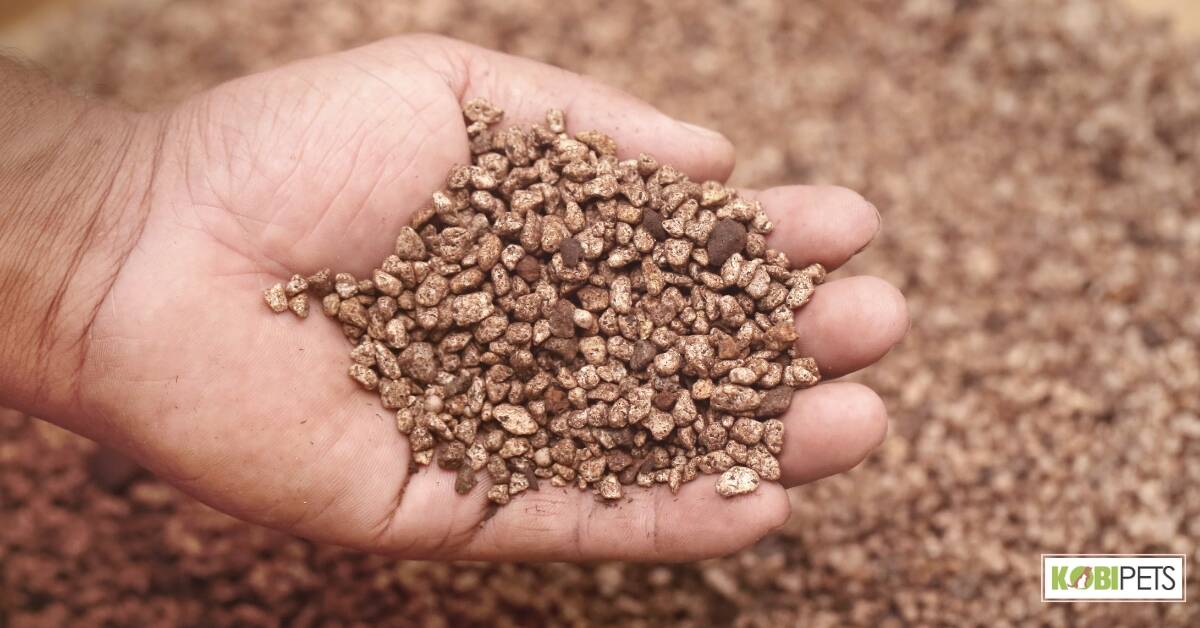
Selecting Livestock
When it comes to selecting livestock for your saltwater reef tank, a bit of research and planning will go a long way. After ensuring that the equipment necessary for a healthy, sustainable tank is in place, it is time to think about which coral and fish species best suit your individual setup and interests.
Consider carefully the types of creatures you want to house as well as their particular needs so that they can thrive in their new home.
| Livestock type | Characteristics | Suitable for |
| Corals | Require certain water conditions and temperature, require strong lighting, and appropriate water flow. Different species of corals grow at different rates and need to be fed specific nutrients. |
Marine tanks with stable pH levels, high-intensity lighting, and good circulation.
|
| Fish | Choose slow-moving fish that are compatible with each other in terms of size and temperament. It is best to research the species before adding it to your tank as some fish may not be suitable for a reef tank environment. |
Saltwater aquariums with a variety of sizes and temperaments.
|
| Invertebrates | Most invertebrates are sensitive to changes in their environment, so stability must be maintained. They also need regular feeding since they mostly eat plankton or microalgae which are not usually found in a reef tank naturally. |
Stable marine tanks, with the right food sources available for them.
|
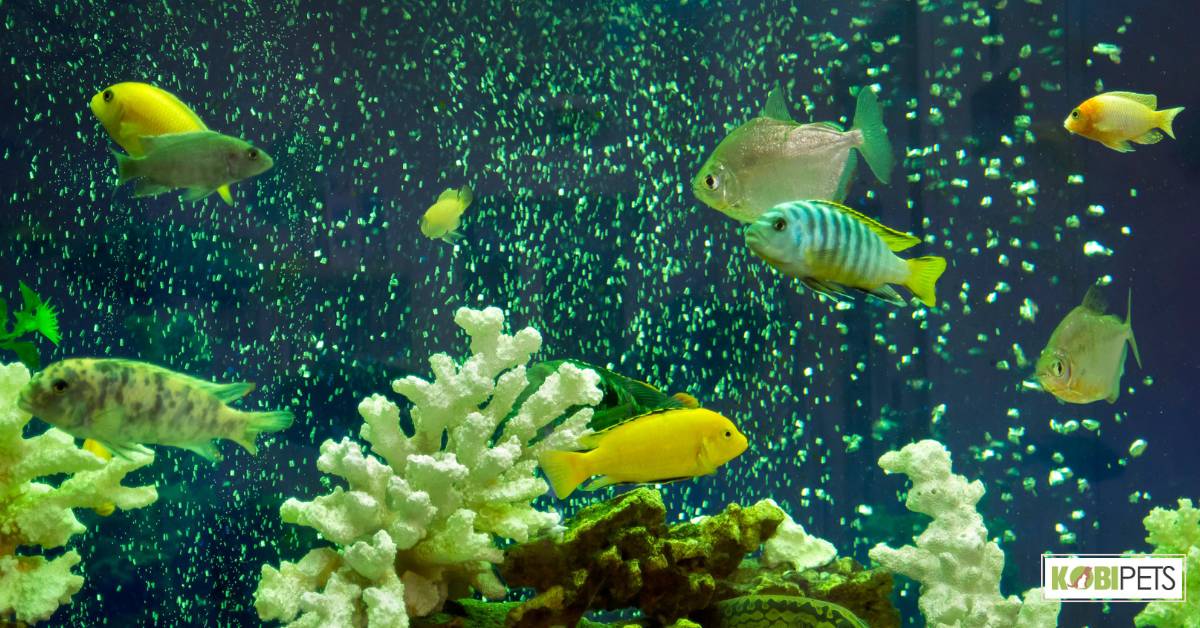
Tank Maintenance
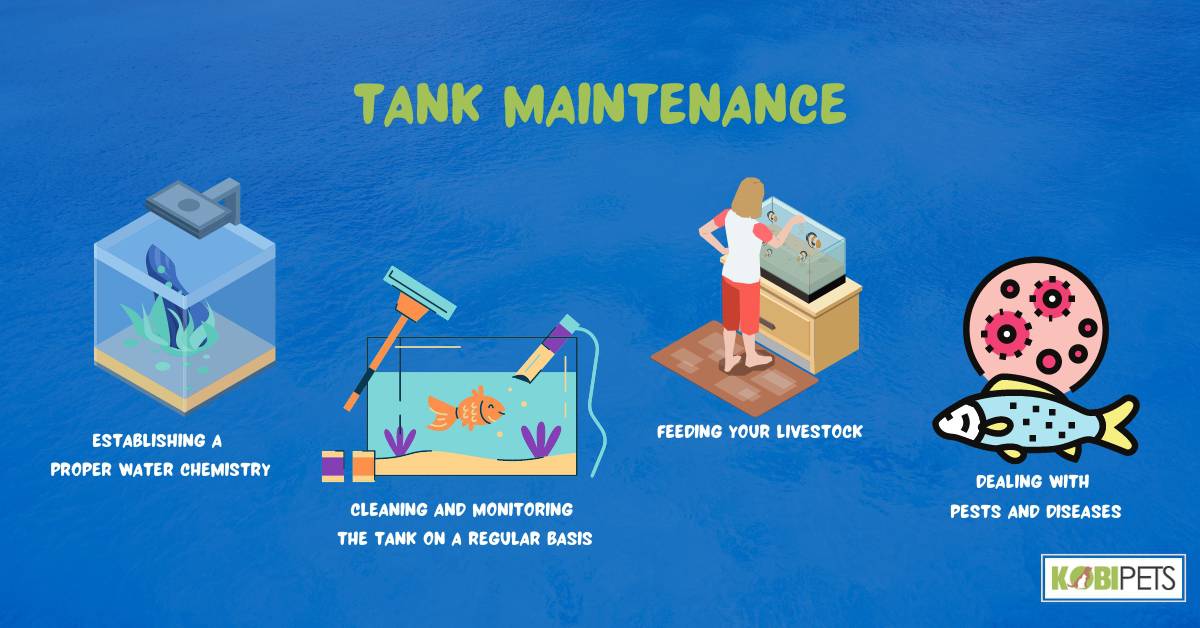
Establishing a Proper Water Chemistry
Maintaining proper water chemistry for a saltwater reef tank is essential for the health of your tank’s inhabitants. Testing and monitoring the parameters of your tank water regularly, at least once a week, ensure that elements such as salinity, alkalinity, nitrate, and pH are all properly balanced.
Changing out 10-15 percent of your tank water every two to four weeks with dechlorinated fresh water can help maintain proper water chemistry. It is also important to select additives and treatments with caution to avoid any disruption in the water chemistry.
For example, you should use calcium and alkalinity balancing treatments specifically designed for aquaria and buffer the alkaline levels of your aquarium accordingly. With careful attention to the ongoing maintenance needs of your aquarium’s environment, you will be able to maintain a healthy reef tank.
Cleaning and Monitoring the Tank on a Regular Basis
Maintaining a saltwater reef tank is a rewarding experience, but it also requires consistent cleaning and monitoring to ensure that everything is working properly. Regular tank maintenance should begin as soon as the tank has been set up with the necessary equipment and species.
Cleaning the filtration system, substrate, decorations, and tank walls can be done on a weekly basis, or when odors or excessive algae become present. Monitoring ammonia, pH, nitrite, and nitrate levels are also essential to clean water in the aquarium and healthy fish; it is best to test these levels three times a week at least.
Additionally, regular water changes should be completed once a month or at least every six weeks – this not only helps maintain ideal water chemistry but keeps your living environment looking fresh and beautiful as well.
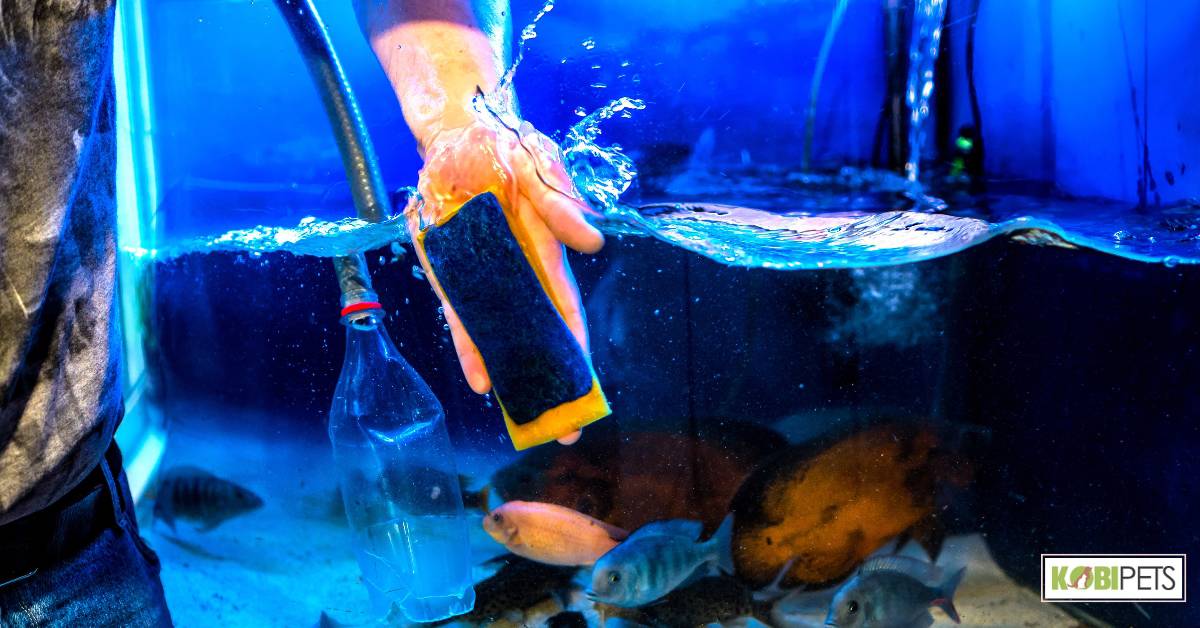
Feeding Your Livestock
For beginner aquarists, maintaining a saltwater reef tank can be daunting. Feeding your livestock is an important step in keeping their environment healthy and successful.
To feed your livestock properly, it is essential to provide them with a balanced diet that includes both herbivorous and carnivorous foods as well as vitamins and minerals to ensure they get the nourishment they need.
It is also important to remember that not all tanks contain fish or coral and each of these organisms has different requirements for nutrition and overall health. Experienced aquarists often recommend considering the various diets required for different livestock as well as researching specific nutritional needs for individual species.
Dealing with Pests and Diseases
When setting up a saltwater reef tank, proper pest and disease management is essential for maintaining the health of aquatic life. The most critical step in preventing pests and diseases is to carefully quarantine new fish or corals for at least four weeks.
During this time, pests can be spotted so that preventive measures can be taken, such as using a copper-based treatment. Furthermore, proper management of water quality is also important, since poor water conditions can increase stress on your tank inhabitants and make them more susceptible to disease.
Regular monitoring for outbreaks and making adjustments to salinity as needed can also help prevent infestations from occurring. Finally, diligent tank maintenance by removing debris and uneaten food will help ensure your tank remains in good condition.
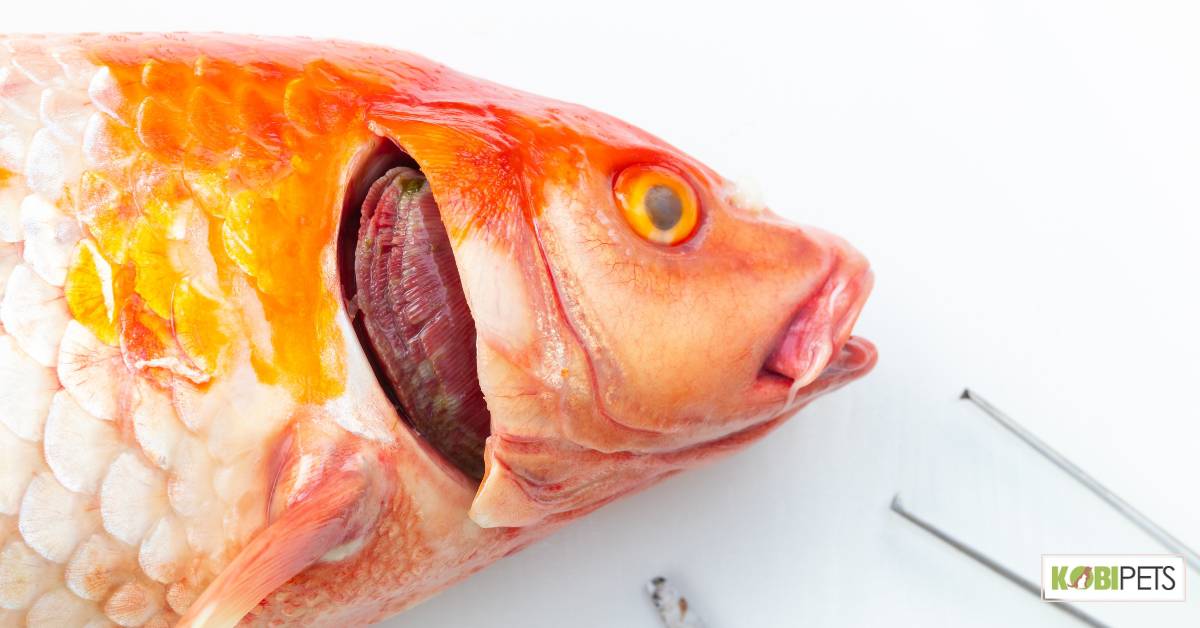
In Conclusion
Setting up a saltwater reef tank is an exciting and rewarding experience. With the right equipment, substrate, and livestock selection, you can create a beautiful home for your aquatic creatures and enjoy hours of entertainment in the process.
If you follow this beginner’s guide to setting up a saltwater reef tank, you’ll be well on your way to creating an impressive and sustainable environment for your marine life.
